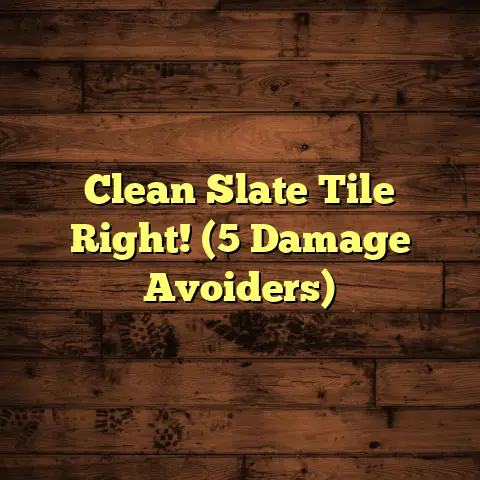Fix Soft Laminate Spots Now! (1-Step Cure!)
I’m a flooring contractor, and believe me, I’ve seen it all.
One of the most common headaches I encounter is soft spots in laminate flooring.
It’s like a sneaky little gremlin attacking your beautiful floors.
These spots can make your floor feel spongy, look uneven, and just generally detract from the overall vibe of your space.
But don’t worry, you’re not alone!
Many homeowners face this issue, and the good news is, it’s often fixable without calling in a professional.
I’m going to let you in on a little secret: a simple, one-step cure that can save you time, money, and a whole lot of frustration.
Trust me, the satisfaction you’ll get from tackling this DIY project is totally worth it.
Ready to roll up your sleeves and get your floors back in tip-top shape? Let’s dive in!
Section 1: Understanding Soft Spots in Laminate Flooring
So, what exactly are these “soft spots” we’re talking about?
In the context of laminate flooring, a soft spot is an area that feels weak or spongy underfoot.
Instead of the firm, solid feel you expect, it gives way slightly when you apply pressure.
Think of it like stepping on a slightly deflated basketball. Not fun, right?
But how do these pesky spots even occur in the first place?
There are a few common culprits.
-
Moisture Damage: This is the big one. Laminate flooring, while durable, isn’t waterproof. If water seeps in through spills, leaks, or even excessive humidity, it can weaken the core of the laminate planks. This weakened core then becomes soft and susceptible to pressure.
-
Poor Installation: A properly installed laminate floor should have a level subfloor and adequate expansion gaps around the perimeter. If the subfloor is uneven, or if the planks are installed too tightly, it can create stress points that lead to soft spots over time.
-
Heavy Furniture: Placing extremely heavy furniture on laminate flooring without proper support can also contribute to the problem. The concentrated weight can compress the core material, especially if there’s already some underlying weakness.
Signs You Have a Soft Spot
Identifying a soft spot is usually pretty straightforward. Here’s what to look for:
-
Visual Cues: Sometimes, you can actually see a slight dip or unevenness in the affected area. The laminate planks might appear slightly warped or buckled.
-
Physical Tests: This is the most reliable way to detect a soft spot. Simply walk around your floor and pay attention to how it feels under your feet. If you notice an area that feels softer or more “squishy” than the surrounding floor, you’ve likely found a soft spot. You can also gently press down on the area with your hand to feel for any give.
Why Address Soft Spots Promptly?
Ignoring a soft spot might seem like no big deal, but trust me, it’s a recipe for disaster.
Here’s why it’s crucial to address them ASAP:
-
Prevent Further Damage: The longer you leave a soft spot unattended, the more likely it is to worsen. The weakened core material will continue to degrade, potentially leading to cracks, chips, or even complete plank failure.
-
Safety Hazard: Soft spots can create tripping hazards, especially for young children or elderly individuals.
-
Aesthetic Appeal: Let’s be honest, soft spots are just plain ugly. They detract from the overall appearance of your floor and can make your entire home look less appealing.
-
Costly Repairs: Addressing a small soft spot early on is far less expensive than replacing an entire section of flooring later.
According to a 2023 report by HomeAdvisor, the average cost to repair laminate flooring ranges from \$200 to \$800, depending on the extent of the damage.
However, replacing a larger section of flooring can easily cost upwards of \$1,000.
So, nipping those soft spots in the bud is a smart financial move.
Section 2: The 1-Step Cure Explained
Alright, let’s get down to the nitty-gritty.
I am so excited to share with you this one-step solution for fixing soft spots in your laminate flooring.
It’s a game-changer, I promise!
Now, before I reveal the magic trick, let me preface this by saying that this method works best for minor soft spots caused by slight moisture damage or compression.
If you’re dealing with severe water damage or widespread issues, you might need to consider replacing the affected planks.
But for those small, annoying soft spots, this solution is a lifesaver.
The One-Step Solution: Injecting Wood Hardener
Yes, you heard that right! The secret weapon is wood hardener.
Wood hardener is a liquid solution designed to penetrate and strengthen deteriorated wood fibers.
It works by soaking into the weakened core of the laminate plank, solidifying the area, and restoring its structural integrity.
It’s like giving your floor a super-strength vitamin boost!
Step-by-Step Guide
Here’s how to implement this one-step cure:
Step 1: Gather Your Supplies
Before you start, make sure you have everything you need on hand. This will save you time and prevent frustration later on.
Here’s what you’ll need:
-
Wood Hardener: I recommend a product like Minwax Wood Hardener or PC-Petrifier Wood Hardener. You can find these at most hardware stores or online retailers.
-
Drill with a Small Drill Bit: You’ll need a drill bit that’s small enough to create a discreet hole in the laminate plank. A 1/16″ or 1/32″ drill bit should do the trick.
-
Syringe or Eye Dropper: This will be used to inject the wood hardener into the soft spot. A small syringe (without the needle, of course!) or an eye dropper works perfectly.
-
Painter’s Tape: This will help protect the surrounding area and prevent any accidental spills.
-
Clean Cloth or Paper Towels: For wiping up any excess wood hardener.
-
Weight (Optional): A heavy book or a sandbag can be used to apply pressure to the area while the wood hardener dries.
Step 2: Prepare the Area
Before you start drilling, it’s important to clean the area thoroughly.
Remove any dirt, dust, or debris from the surface of the laminate plank.
Use a damp cloth to wipe down the area, and then dry it completely.
Next, apply painter’s tape around the perimeter of the soft spot.
This will protect the surrounding flooring from any accidental spills or drips of wood hardener.
Step 3: Drill a Pilot Hole
Now comes the slightly nerve-wracking part: drilling the pilot hole.
Don’t worry, it’s not as scary as it sounds!
Using your drill with the small drill bit, carefully drill a small hole directly into the center of the soft spot.
The hole should be just deep enough to penetrate the surface of the laminate plank and reach the weakened core material.
Be gentle and avoid applying too much pressure, as this could damage the surrounding area.
Step 4: Inject the Wood Hardener
This is where the magic happens!
Using your syringe or eye dropper, carefully draw up some wood hardener from the container.
Insert the tip of the syringe or eye dropper into the pilot hole and slowly inject the wood hardener into the soft spot.
You’ll want to inject enough wood hardener to saturate the weakened core material, but avoid overfilling the hole.
If you see any wood hardener seeping out of the hole, stop injecting and wipe up the excess with a clean cloth or paper towel.
Step 5: Apply Pressure (Optional)
Once you’ve injected the wood hardener, you can apply pressure to the area to help it penetrate deeper into the core material.
Place a heavy book or a sandbag directly over the soft spot and leave it in place for several hours, or even overnight.
This will help ensure that the wood hardener is fully absorbed and that the area dries evenly.
Step 6: Allow to Dry
Now comes the hardest part: waiting!
The wood hardener needs time to fully dry and harden.
The drying time will vary depending on the specific product you use, but it’s generally recommended to wait at least 24 hours before walking on the area.
Check the manufacturer’s instructions for specific drying times.
Step 7: Remove the Tape and Enjoy Your Fixed Floor!
Once the wood hardener is completely dry, you can remove the painter’s tape and admire your handiwork!
The soft spot should now be significantly firmer and more stable.
If the area still feels slightly soft, you can repeat the process, injecting a small amount of additional wood hardener and allowing it to dry completely.
Tips for Preparing the Area
-
Identify the Source of Moisture: Before you start the repair, it’s crucial to identify and address the source of the moisture that caused the soft spot in the first place. Otherwise, the problem is likely to recur. Check for leaks around plumbing fixtures, windows, or doors. Ensure that your home has adequate ventilation to prevent excessive humidity.
-
Clean the Area Thoroughly: As I mentioned earlier, cleaning the area is essential for ensuring that the wood hardener can properly penetrate the core material. Use a mild detergent and water to remove any dirt, dust, or debris.
-
Consider the Plank’s Color: If you’re concerned about the appearance of the pilot hole, you can try to match the color of the wood hardener to the color of your laminate flooring. Some wood hardeners are available in different tints or can be tinted with wood stain.
Section 3: Benefits of the 1-Step Cure
Now that you know how to perform this one-step cure, let’s talk about why it’s such a great option.
Compared to other solutions, this method offers a ton of advantages.
Saves Time and Money
One of the biggest benefits of this one-step cure is that it saves you both time and money.
Hiring a professional flooring contractor to repair a soft spot can be expensive, especially if they need to replace entire planks.
According to Fixr.com, the cost to hire a professional to repair laminate flooring can range from \$150 to \$500, depending on the complexity of the job.
This one-step cure, on the other hand, costs only a few dollars for the wood hardener and a few minutes of your time.
Plus, you don’t have to wait for a contractor to schedule an appointment or disrupt your daily routine.
DIY Accomplishment
There’s a certain satisfaction that comes from tackling a DIY project and successfully fixing something yourself.
This one-step cure is a perfect example of a project that’s easy enough for most homeowners to handle, yet impactful enough to make a noticeable difference in the appearance and functionality of their home.
You’ll feel a sense of pride knowing that you were able to solve the problem without relying on outside help.
Less Invasive Than Other Methods
Some methods for repairing soft spots in laminate flooring involve removing and replacing entire planks.
This can be a messy and disruptive process, requiring specialized tools and skills.
The one-step cure, on the other hand, is a much less invasive approach.
It doesn’t require any demolition or major construction, and it can be completed with minimal disruption to your home.
Real-Life Success Stories
I’ve personally seen this method work wonders for countless homeowners.
Here are a few examples:
-
Sarah from Ohio: Sarah had a small soft spot near her kitchen sink caused by a leaky faucet. She used the one-step cure with wood hardener, and within 24 hours, the soft spot was gone. She saved herself hundreds of dollars by avoiding a professional repair.
-
David from California: David noticed a soft spot under his heavy bookshelf in the living room. He injected wood hardener into the area, applied pressure with a sandbag, and the soft spot disappeared. He was thrilled with the results and the money he saved.
-
Maria from Florida: Maria had a soft spot in her laminate flooring caused by high humidity levels. She used the one-step cure, along with a dehumidifier to control the moisture, and the soft spot was successfully repaired.
These are just a few examples of how this one-step cure can help homeowners fix soft spots in their laminate flooring quickly, easily, and affordably.
Section 4: Maintenance Tips to Prevent Future Soft Spots
Okay, so you’ve successfully fixed your soft spot using the one-step cure.
Awesome! But the job isn’t quite done yet.
To prevent future soft spots from popping up, it’s crucial to implement a few simple maintenance practices.
Think of it as an investment in the long-term health and beauty of your laminate floors.
Proper Cleaning Techniques
-
Sweep or Vacuum Regularly: The first line of defense against soft spots is to keep your laminate floors clean. Sweep or vacuum regularly to remove dirt, dust, and debris that can scratch the surface and allow moisture to penetrate.
-
Use a Damp Mop: When mopping, use a damp mop and a laminate-specific cleaner. Avoid using excessive water, as this can seep into the seams and cause damage.
-
Wipe Up Spills Immediately: This is crucial. The longer a spill sits on your laminate floor, the greater the chance that it will seep in and cause damage. Wipe up spills immediately with a clean, dry cloth.
-
Avoid Abrasive Cleaners: Never use abrasive cleaners, scouring pads, or steel wool on your laminate floors. These can scratch the surface and damage the protective coating.
Moisture Control
-
Address Leaks Promptly: As I mentioned earlier, leaks are a major cause of soft spots in laminate flooring. Check for leaks around plumbing fixtures, windows, and doors regularly. Address any leaks promptly to prevent water damage.
-
Use Doormats: Place doormats at all entrances to your home to trap dirt, dust, and moisture before they can be tracked onto your laminate floors.
-
Control Humidity Levels: High humidity levels can also contribute to soft spots. Use a dehumidifier to control humidity levels in your home, especially in areas with poor ventilation.
-
Avoid Wet Mopping: As much as possible, avoid wet mopping your laminate floors. Instead, opt for a damp mop or a microfiber mop.
Furniture Placement
-
Use Furniture Pads: Place furniture pads under the legs of all heavy furniture to protect your laminate floors from scratches and dents.
-
Avoid Dragging Furniture: Never drag furniture across your laminate floors. Always lift and carry furniture to avoid scratching or damaging the surface.
-
Distribute Weight Evenly: When placing heavy furniture on your laminate floors, try to distribute the weight evenly. Avoid placing all the weight on a single point, as this can compress the core material and lead to soft spots.
Regular Inspections
-
Walk Around Your Floors Regularly: Take a few minutes each month to walk around your floors and inspect them for any signs of damage, such as soft spots, scratches, or dents.
-
Pay Attention to High-Traffic Areas: Pay special attention to high-traffic areas, such as hallways and doorways, as these are more prone to wear and tear.
-
Seek Professional Advice: If you notice any persistent problems or if you’re unsure about how to address a particular issue, don’t hesitate to seek professional advice from a flooring contractor.
By following these simple maintenance tips, you can significantly reduce the risk of future soft spots and keep your laminate floors looking beautiful for years to come.
Section 5: Troubleshooting Common Issues
Even with the best instructions, sometimes things don’t go exactly as planned.
Let’s address some potential complications you might encounter while implementing the one-step cure.
Difficulty Detecting Soft Spots
Sometimes, it can be tricky to pinpoint the exact location of a soft spot, especially if it’s small or subtle.
Here are a few tips for improving your detection skills:
-
Use a Level: Place a level on the floor and look for any areas where the level is not sitting flush. This can indicate a slight dip or unevenness caused by a soft spot.
-
Shine a Light at an Angle: Shine a flashlight or other light source at a low angle across the floor. This will highlight any imperfections or unevenness in the surface.
-
Listen for Hollow Sounds: Tap on the floor with your knuckles and listen for any hollow sounds. A hollow sound can indicate that the core material is weakened or damaged.
Unexpected Results After the Fix
In some cases, you might not see the desired results after implementing the one-step cure.
Here are a few possible reasons why:
-
Insufficient Wood Hardener: You might not have injected enough wood hardener to fully saturate the weakened core material. Try injecting a small amount of additional wood hardener and allowing it to dry completely.
-
Severe Damage: The soft spot might be too severe for the one-step cure to fix. If the core material is extensively damaged, you might need to replace the affected planks.
-
Incorrect Product: You might have used the wrong type of wood hardener. Make sure you’re using a product that’s specifically designed for repairing deteriorated wood fibers.
Wood Hardener Not Penetrating
Sometimes, the wood hardener might not penetrate the core material properly.
Here are a few tips for improving penetration:
-
Use a Smaller Drill Bit: A smaller drill bit will create a smaller hole, which can help the wood hardener penetrate more easily.
-
Apply Pressure: Applying pressure to the area while the wood hardener dries can help it penetrate deeper into the core material.
-
Use a Vacuum: Use a vacuum cleaner to create a slight vacuum over the pilot hole. This can help draw the wood hardener into the core material.
Pilot Hole Too Visible
If you’re concerned about the appearance of the pilot hole, here are a few things you can do:
-
Use a Color-Matching Filler: Use a color-matching wood filler to fill the pilot hole after the wood hardener has dried.
-
Conceal with Furniture: If possible, position furniture or a rug over the area to conceal the pilot hole.
-
Embrace the Imperfection: Remember that a small pilot hole is a minor imperfection compared to the overall improvement in the stability and appearance of your floor.
Stay Patient and Persistent
Remember that some trial and error may be part of the process.
Don’t get discouraged if you don’t see results immediately.
Be patient, persistent, and willing to experiment until you find a solution that works for you.
Conclusion
So there you have it!
The one-step cure for soft spots in laminate flooring, revealed.
I truly believe that this simple yet effective method can empower you to take control of your home maintenance and save yourself a lot of time, money, and frustration.
Don’t let those pesky soft spots ruin the beauty and functionality of your floors any longer.
Take action, apply what you’ve learned, and enjoy the satisfaction of a job well done.
Remember, maintaining your flooring is an investment in the longevity and appearance of your home.
By being proactive and addressing issues promptly, you can keep your floors looking their best for years to come.
Now go forth and conquer those soft spots! You got this!





